Outline:
- I'm renting a Hetzner Storage Box to have access to a remote server which comes with borg. NOTES:
- Hetzner requires ID verification.
- Storage Boxes have very limited functionality (this is what makes them cheaper than most other VPS)
- To encrypt and upload my files, I'm using Pika Backup for a simple UI.
Setting Up The Server
I am using a Hetzner Storage Box. It's rather cheap and comes with borg out of the box. (I'm assuming that any other server with borg will work as well though).
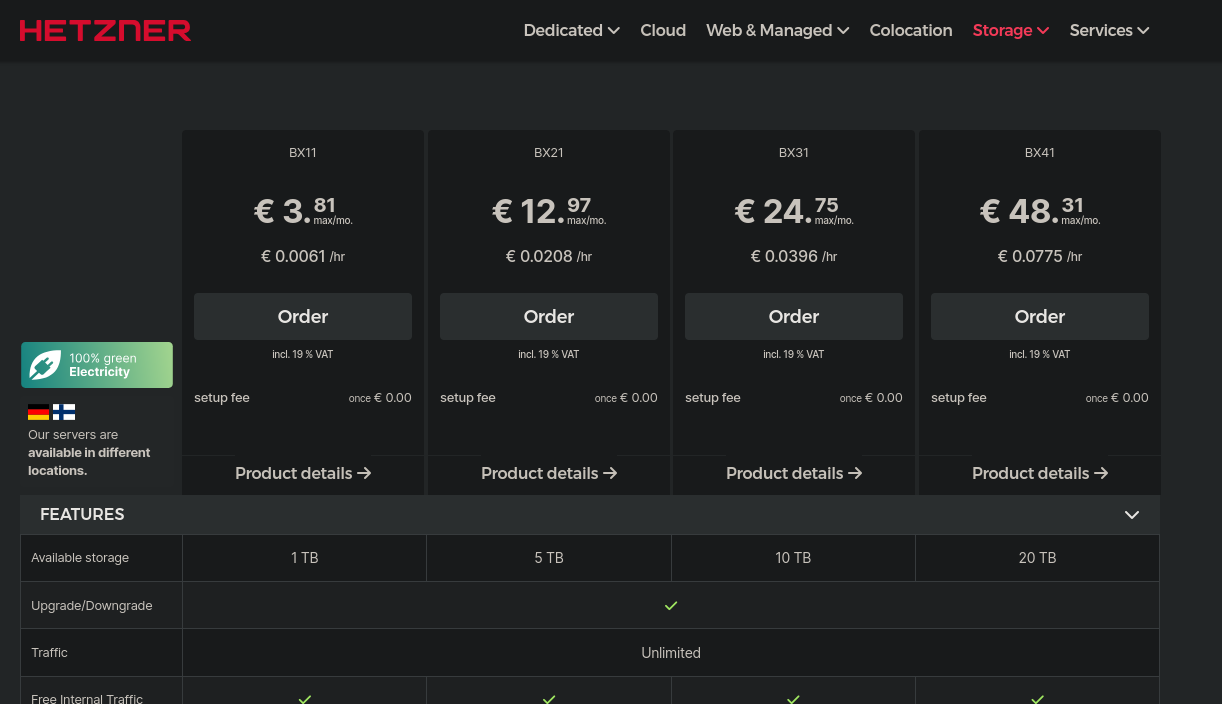
- Create a Hetzner Account. Verify your ID and setup two factor authentification.
- Go to console.hetzner.com. Click on the default project (or create a new one I guess).
- On the Dashboard on the left bar, click "Storage Boxes" and then "Create Storage Box".
- Pick your desired server location.
- Pick your storage size. The higher the storage capacity, the more expensive the server is (see the listed prices).
- NOTE: "You can scale [the storage size] up or down to fit your current needs, and without losing data or having to migrate it manually." (source).
- So I recommend picking the smallest size which can hold your backup. In my case, 1TB is more than enough (as of writing).
- Access: I recommend using SSH Keys for authentification. Then the password is optional. In either case, the password can be reset later within the Hetzner web-interface.
- Additional Settings: Make sure SSH Support and External Reachabilty are enabled.
- I didn't touch the rest of the server configuraion.
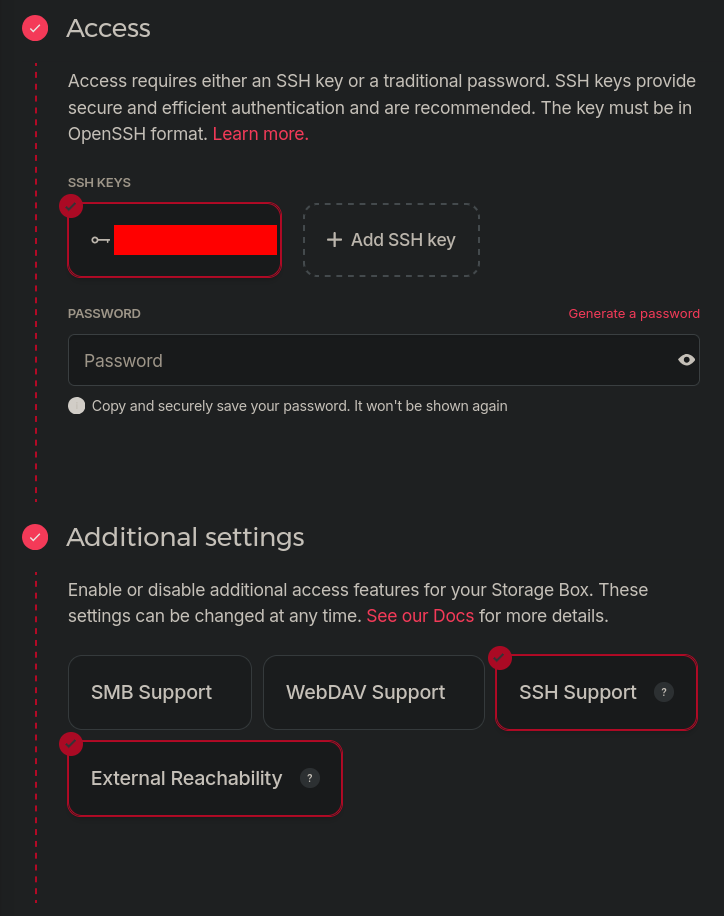
After completing the order (and waiting a few minutes for the server to setup) you can see your server address: On console.hetzner.com, click "Storage Boxes" on the left (I recommend pinning this) and click on your server. You should then see
- An address:
u123456.your-storagebox.de - Your username:
u123456 - The ssh port:
23
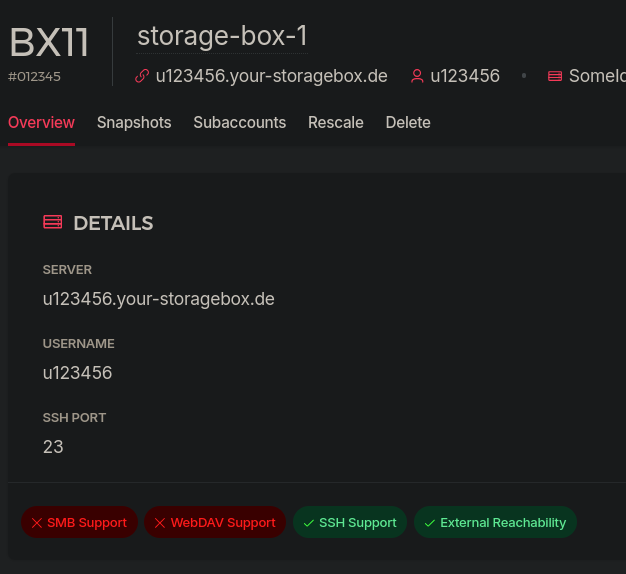
If you want to you can login into your storage box via ssh.
# Direct login:
# -Port- --User- ------Address-------------
> ssh -p 23 u123456@u123456.your-storagebox.de
# For convenience: Add the server to your ~/.ssh/config
Host StorageBox
HostName u123456.your-storagebox.de
User u123456
Port 23
RequestTTY force
# Then you can login into the server via
> ssh StorageBox
Once you are logged into the server, you can type help to get an overview of the available commands.
As I said, the usability of it is quite limited.
Client: Initial Setup of the Backup
Install Pika Backup. Then:
- Click on the "+" on the top left
- Under "Create new Repository", click "Remote Location"
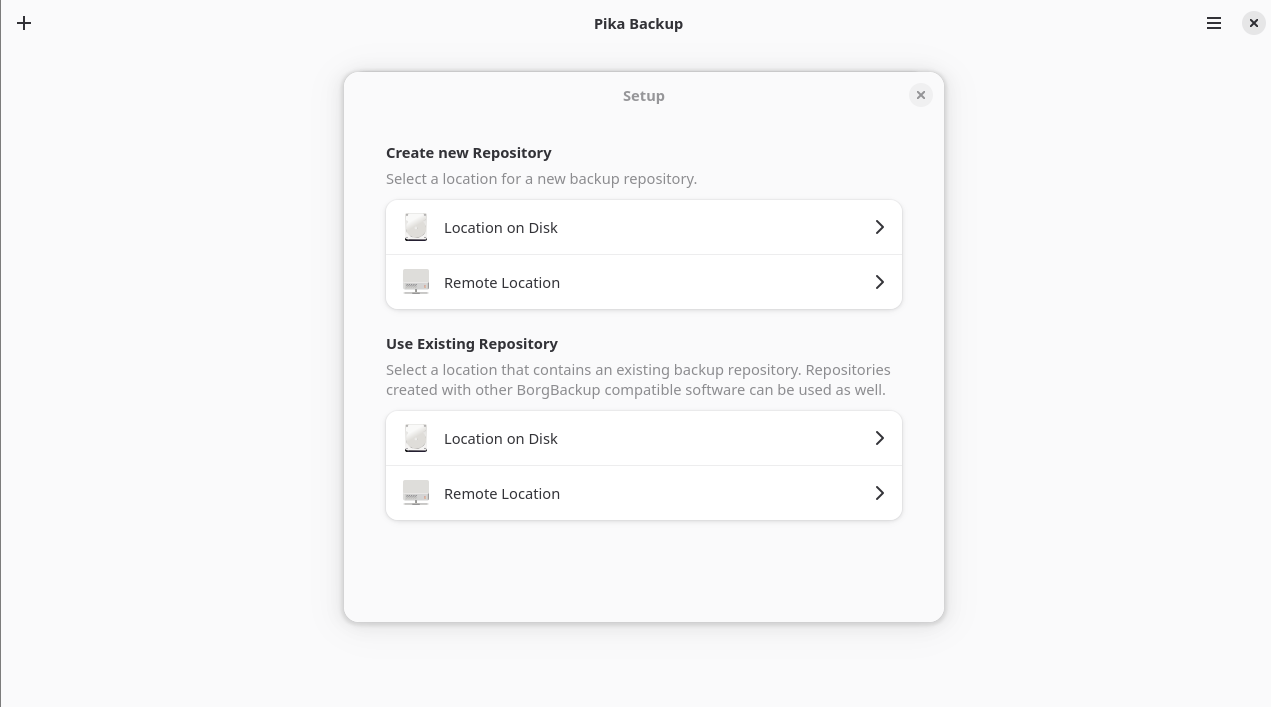
Then enter a URL in the following format:
# Format:
ssh://[user]@[address]:[port]/~/[some directory name]
# For example:
ssh://u123456@u123456.your-storagebox.de:23/~/pika_backup
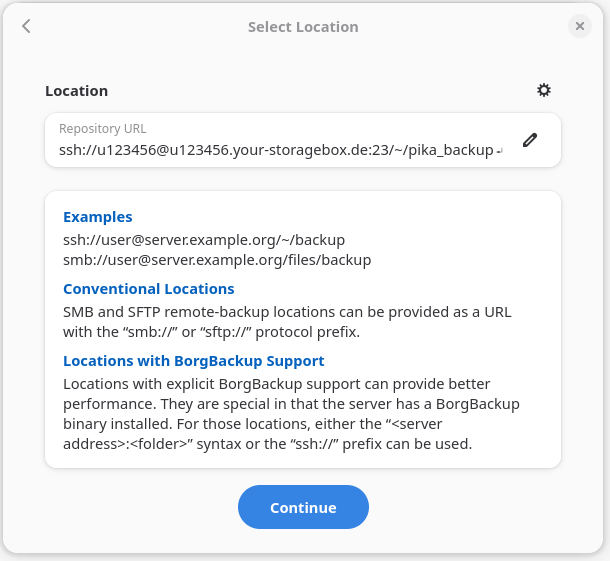
Set an encryption password. You will need to enter this password whenever you are trying to access the backup.
Now you only need to select which files to backup / which files to ignore. Select the profile you have set up. Then:
- You can add files to backup by clicking on the "+" next to "Files to Back Up".
- To exclude files/directories, scroll down and click on the "+" next to "Exclude from Backup"
- To remove any existing entries, click on the "X" on the right side of the entry.
- Your configuration will be saved to your profile.
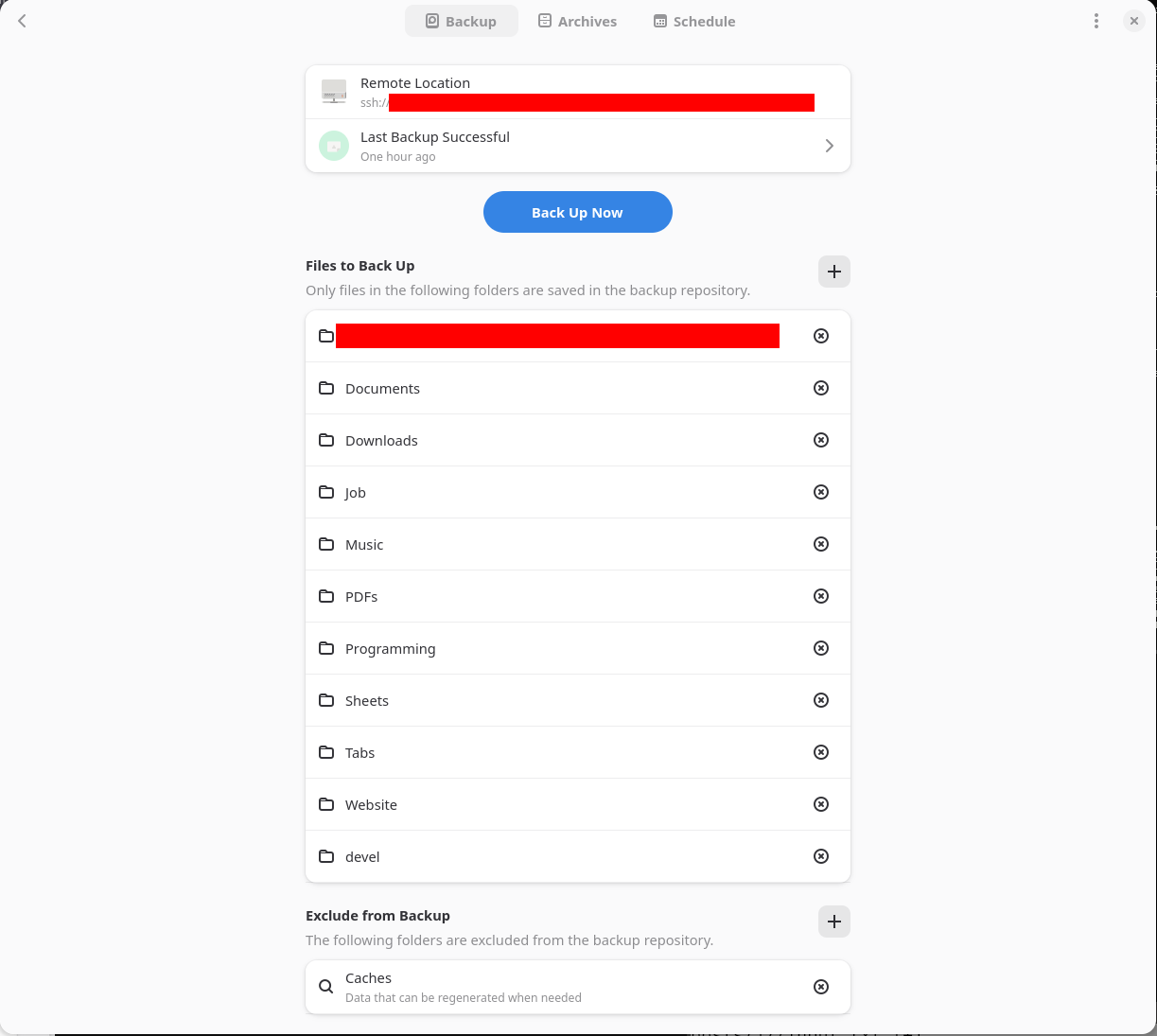
Creating / Updating a Backup
Once everything is setup, you just have to press the big blue "Back Up Now" button (see abov, and it will ask you for the encryption password).
- If it's the first time you are backing up files to the server, it might take a long time to upload all of your files, depending on your upload speeds (and the speeds of the remote server).
- If you already have a backup, pressing the button will perform an incremental backup, meaning it will only upload changes which occured since your previous backup.
- In either case, you will get a window listing what files are currently uploaded/checked, as well as a rough estimation on how long this process will take.
Once your backup is done, your backup should be listed under "Archives":
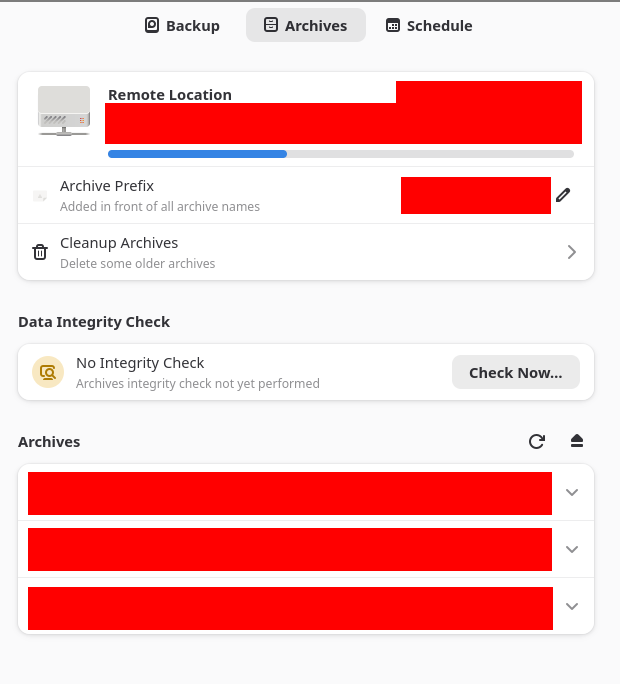
You might be interested in scheduling automatic backups. I haven't configured this (yet), but you can press on "Schedule" at the top for some additional configuration.
Accessing Archives
You can browse through the files (and copy files over) by selecting the archive and clicking on "Browse saved files". In the background, the archive will be mounted in a temporary directory, and you default file explorer will open. Once you are done, press the unmount-symbol next to "Archives" above the archives-list to unmount the files.
In case you don't have a default file explorer, pika will throw an error about how it couldn't find
the default application:
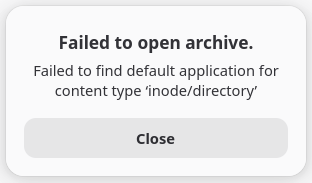
In that case, unmount the files (as described above) and close pika. We will retrieve the mount location by looking at the borg-commands used by pika.
# Run pika from the terminal with debug messages:
> G_MESSAGES_PREFIXED="" G_MESSAGES_DEBUG=all pika-backup
# Try to access the archive via the UI as described above.
# (enter your encryption password if prompted).
# Pika prints the borg mount command in the terminal.
# Once the error message is thrown, you can scroll up in the terminal
# and look for something like this:
pika-backup-INFO: 14:25:11.158: src/borg/process.rs:465:0: Running managed borg command: [
"mount",
"--rsh",
"ssh -o BatchMode=yes -o StrictHostKeyChecking=accept-new",
"--log-json",
"--remote-path=borg-1.4",
"--consider-checkpoints",
"-o",
"umask=0000,uid=1000",
"--",
"ssh://[redacted]",
"[some mount path]",
]
You can browse the files manually by navigating to [some mount path].
Once you are done, make sure that you aren't accessing the files / directories anymore, and then you can unmount
the directorie as described above.
Using this method, you can extract the console commands used by pika for mounting/unmounting the borg archives if you want to.